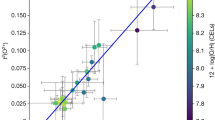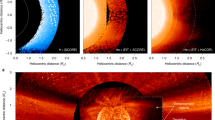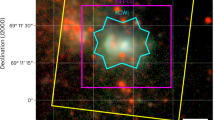Abstract
Almost every helium atom in the Universe was created just a few minutes after the Big Bang through a process commonly referred to as Big Bang nucleosynthesis1,2. The amount of helium that was made during Big Bang nucleosynthesis is determined by combining particle physics and cosmology3. The current leading measures of the primordial helium abundance (YP) are based on the relative strengths of H i and He i emission lines emanating from star-forming regions in local metal-poor galaxies4,5,6,7. As the statistical errors on these measurements improve, it is essential to test for systematics by developing independent techniques. Here we report a determination of the primordial helium abundance based on a near-pristine intergalactic gas cloud that is seen in absorption against the light of a background quasar. This gas cloud, observed when the Universe was just one-third of its present age (zabs = 1.724), has a metal content around 100 times less than that of the Sun, and at least 30% less metal content than the most metal-poor H ii region currently known where a determination of the primordial helium abundance is possible. We conclude that the helium abundance of this intergalactic gas cloud is \(Y = 0.250_{ - 0.025}^{ + 0.033}\), which agrees with the standard model primordial value8,9,10, YP = 0.24672 ± 0.00017. Our determination of the primordial helium abundance is not yet as precise as that derived using metal-poor galaxies, but our method has the potential to offer a competitive test of physics beyond the standard model during Big Bang nucleosynthesis.
This is a preview of subscription content, access via your institution
Access options
Access Nature and 54 other Nature Portfolio journals
Get Nature+, our best-value online-access subscription
$29.99 / 30 days
cancel any time
Subscribe to this journal
Receive 12 digital issues and online access to articles
$119.00 per year
only $9.92 per issue
Buy this article
- Purchase on Springer Link
- Instant access to full article PDF
Prices may be subject to local taxes which are calculated during checkout



Similar content being viewed by others
Data availability
The data that support the plots within this paper and other findings of this study are available from the corresponding author upon reasonable request. The Keck HIRES data are available as a high-level science product from the W. M. Keck Observatory Data Archive at https://koa.ipac.caltech.edu/cgi-bin/KOA/nph-KOAlogin. The fully reduced HST FOS data are available from https://archive.stsci.edu/prepds/fos_agn/. The reduced HST COS data are available at http://archive.stsci.edu/proposal_search.php?mission=hst&id=13491.
References
Alpher, R. A., Bethe, H. & Gamow, G. The origin of chemical elements. Phys. Rev. 73, 803–804 (1948).
Hoyle, F. & Tayler, R. J. The mystery of the cosmic helium abundance. Nature 203, 1108–1110 (1964).
Steigman, G., Schramm, D. N. & Gunn, J. E. Cosmological limits to the number of massive leptons. Phys. Lett. B 66, 202–204 (1977).
Izotov, Y. I., Thuan, T. X. & Guseva, N. G. A new determination of the primordial He abundance using the He i λ10830 Å emission line: cosmological implications. Mon. Not. R. Astron. Soc. 445, 778–793 (2014).
Aver, E., Olive, K. A. & Skillman, E. D. The effects of He i λ10830 on helium abundance determinations. J. Cosmol. Astropart. Phys. 7, 011 (2015).
Peimbert, A., Peimbert, M. & Luridiana, V. The primordial helium abundance and the number of neutrino families. Rev. Mex. Astron. Astrophys. 52, 419–424 (2016).
Fernández, V., Terlevich, E., Díaz, A. I., Terlevich, R. & Rosales-Ortega, F. F. Primordial helium abundance determination using sulphur as metallicity tracer. Mon. Not. R. Astron. Soc. 478, 5301–5319 (2018).
Planck Collaboration et al. Planck 2015 results. XIII. Cosmological parameters. Astron. Astrophys. 594, A13 (2016).
Pitrou, C., Coc, A., Uzan, J.-P. & Vangioni, E. Precision Big Bang nucleosynthesis with improved helium-4 predictions. Phys. Rep 754, 1–66 (2018).
Pattie, R. W. et al. Measurement of the neutron lifetime using a magneto-gravitational trap and in situ detection. Science 360, 627–632 (2018).
Crighton, N. H. M., O’Meara, J. M. & Murphy, M. T. Possible population III remnants at redshift 3.5. Mon. Not. R. Astron. Soc. 457, L44–L48 (2016).
Lehner, N., O’Meara, J. M., Howk, J. C., Prochaska, J. X. & Fumagalli, M. The cosmic evolution of the metallicity distribution of ionized gas traced by Lyman limit systems. Astrophys. J. 833, 283–316 (2016).
Cooke, R. J., Pettini, M. & Steidel, C. C. Discovery of the most metal-poor damped Lyman-α system. Mon. Not. R. Astron. Soc. 467, 802–811 (2017).
Fumagalli, M., O’Meara, J. M. & Prochaska, J. X. Detection of pristine gas two billion years after the Big Bang. Science 334, 1245–1249 (2011).
Cooke, R. J., Pettini, M. & Steidel, C. C. One percent determination of the primordial deuterium abundance. Astrophys. J. 855, 102–117 (2018).
Fechner, C. et al. The UV spectrum of HS 1700 + 6416. I. Predicting the metal line content of the far UV spectrum. Astron. Astrophys. 455, 73–90 (2006).
Reimers, D. & Vogel, S. He i absorption lines in high redshift Lyman limit systems of the QSO HS 1700 + 6416. Astron. Astrophys. 276, L13–L16 (1993).
Syphers, D. & Shull, J. M. The He ii post-reionization epoch: HST/COS observations of the quasar HS1700 + 6416. Astrophys. J. 765, 119–128 (2013).
O’Meara, J. M. et al. The first data release of the KODIAQ survey. Astron. J. 150, 111–121 (2015).
O’Meara, J. M. et al. The second data release of the KODIAQ survey. Astron. J. 154, 114–118 (2017).
Evans, I. N. & Koratkar, A. P. A complete atlas of recalibrated Hubble Space Telescope Faint Object Spectrograph spectra of active galactic nuclei and quasars. I. Pre-COSTAR spectra. Astrophys. J. Suppl. 150, 73–164 (2004).
Cooke, R. J., Pettini, M., Jorgenson, R. A., Murphy, M. T. & Steidel, C. C. Precision measures of the primordial abundance of deuterium. Astrophys. J. 781, 31–46 (2014).
Ferland, G. J. et al. The 2017 release Cloudy. Astron. Astrophys. 53, 385–438 (2017).
Haardt, F. & Madau, P. Radiative transfer in a clumpy universe. IV. New synthesis models of the cosmic UV/X-ray background. Astrophys. J. 746, 125–144 (2012).
Shapley, A. E. et al. Ultraviolet to mid-infrared observations of star-forming galaxies at z ~ 2: stellar masses and stellar populations. Astrophys. J. 626, 698–722 (2005).
Asplund, M., Grevesse, N., Sauval, A. J. & Scott, P. The chemical composition of the Sun. Annu. Rev. Astron. Astrophys. 47, 481–522 (2009).
Foreman-Mackey, D., Hogg, D. W., Lang, D. & Goodman, J. emcee: the MCMC hammer. Publ. Astron. Soc. Pacif 125, 306–312 (2013).
Izotov, Y. I. & Thuan, T. X. Heavy-element abundances in blue compact galaxies. Astrophys. J. 511, 639–659 (1999).
Fumagalli, M., O’Meara, J. M. & Prochaska, J. X. The physical properties of z > 2 Lyman limit systems: new constraints for feedback and accretion models. Mon. Not. R. Astron. Soc. 455, 4100–4121 (2016).
Izotov, Y. I., Thuan, T. X. & Stasińska, G. The primordial abundance of 4He: a self-consistent empirical analysis of systematic effects in a large sample of low-metallicity H ii regions. Astrophys. J. 662, 15–38 (2007).
Muslimov, E. et al. POLLUX: a UV spectropolarimeter for the LUVOIR space telescope project. Preprint at https://arxiv.org/abs/1805.09067 (2018).
O’Meara, J. M., Prochaska, J. X., Worseck, G., Chen, H.-W. & Madau, P. The HST/ACS + WFC3 survey for Lyman limit systems. II. Science. Astrophys. J. 765, 137–165 (2013).
Reimers, D. et al. The luminous quasar HS1700 + 6416 and the shape of the ‘big bump’ below 500 A. Astron. Astrophys. 218, 71–77 (1989).
Morton, D. C. Atomic data for resonance absorption lines. III. Wavelengths longward of the Lyman limit for the elements hydrogen to gallium. Astrophys. J. Suppl. 149, 205–238 (2003).
Verner, D. A., Ferland, G. J., Korista, K. T. & Yakovlev, D. G. Atomic data for astrophysics. II. New analytic FITS for photoionization cross sections of atoms and ions. Astrophys. J. 465, 487–498 (1996).
Faucher-Giguére, C.-A., Lidz, A., Zaldarriaga, M. & Hernquist, L. A new calculation of the ionizing background spectrum and the effects of He ii reionization. Astrophys. J. 703, 1416–1443 (2009).
Fumagalli, M. et al. Absorption-line systems in simulated galaxies fed by cold streams. Mon. Not. R. Astron. Soc. 418, 1796–1821 (2011).
Leitherer, C. et al. Starburst99: synthesis models for galaxies with active star formation. Astrophys. J. Suppl. 123, 3–40 (1999).
Ekström, S. et al. Grids of stellar models with rotation. I. Models from 0.8 to 120 M ⊙ at solar metallicity (z = 0.014). Astron. Astrophys. 537, A146 (2012).
Acknowledgements
We thank G. Worseck for discussions about the HST and COS data of this sightline. During this work, R.J.C. was supported by a Royal Society University Research Fellowship. We acknowledge support from STFC (ST/L00075X/1 and ST/P000541/1). This project has received funding from the European Research Council under the European Union’s Horizon 2020 research and innovation programme (grant agreement number 757535). This work used the DiRAC Data Centric system at Durham University, operated by the Institute for Computational Cosmology on behalf of the STFC DiRAC HPC Facility (www.dirac.ac.uk). This equipment was funded by BIS National E-Infrastructure capital grant ST/K00042X/1, STFC capital grant ST/H008519/1, STFC DiRAC Operations grant ST/K003267/1 and Durham University. DiRAC is part of the National E-Infrastructure. This research has made use of NASA’s Astrophysics Data System.
Author information
Authors and Affiliations
Contributions
Both authors participated in the interpretation and commented on the manuscript. R.J.C. led the project and analysis, and was responsible for the text of the paper. M.F. was responsible for the ionization calculations.
Corresponding author
Ethics declarations
Competing interests
The authors declare no competing interests.
Additional information
Publisher’s note: Springer Nature remains neutral with regard to jurisdictional claims in published maps and institutional affiliations.
Supplementary information
Supplementary Information
Supplementary Table 1, Supplementary Figures 1–5
Rights and permissions
About this article
Cite this article
Cooke, R.J., Fumagalli, M. Measurement of the primordial helium abundance from the intergalactic medium. Nat Astron 2, 957–961 (2018). https://doi.org/10.1038/s41550-018-0584-z
Received:
Accepted:
Published:
Issue Date:
DOI: https://doi.org/10.1038/s41550-018-0584-z
This article is cited by
-
Origin of the elements
The Astronomy and Astrophysics Review (2023)
-
Modelling the chemical evolution of the Milky Way
The Astronomy and Astrophysics Review (2021)



